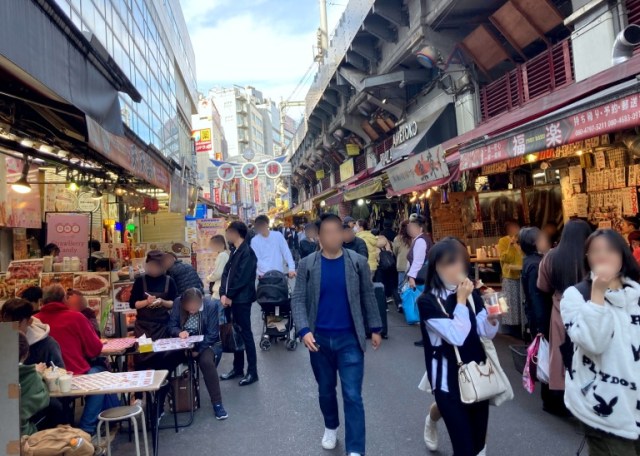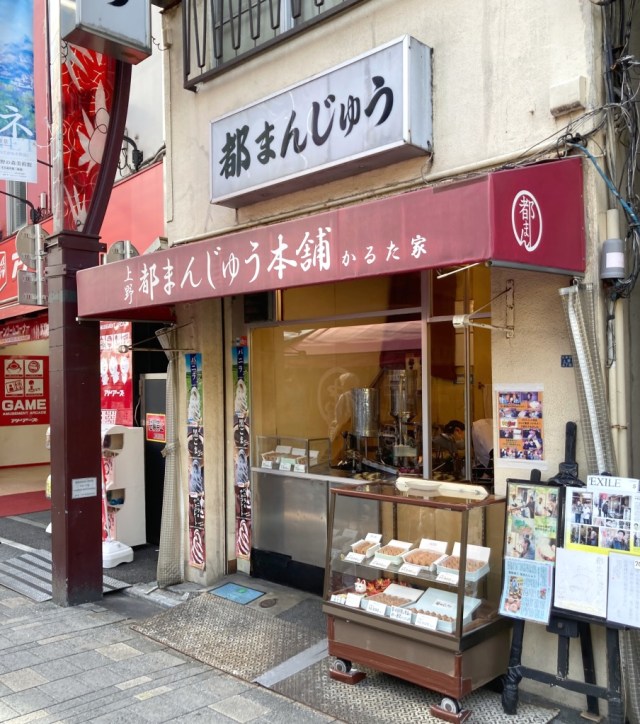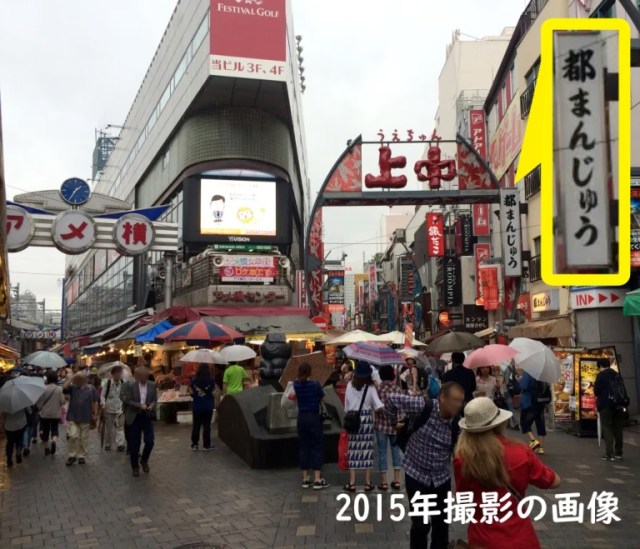
Miyako manju blend into the background in Ueno, but stand out from the crowd in flavor.
It’s not unusual to feel a bit of sensory overload walking around Tokyo’s Ameya Yokocho neighborhood. Pictured above, the network of shopping streets that stretches west of Ueno Station has been the city’s liveliest street market for generations, with boisterously friendly vendors and restaurateurs setting up shop on both sides of the alleyways and calling out to passersby as they hawk all manner of souvenirs, fashions, and food items.
So it can be easy for Ameya Yokocho’s few low-key establishments to get lost in the figurative and literal din of the place, which brings us to Karutaya.
Even Karutaya’s name (かるた家) doesn’t really stand out very much, with the shop instead using most of its sign’s space for its marque product, miyako manju (都まんじゅう), traditional sweet bean-filled cakes.
But Karutaya doesn’t have anyone standing out front, clapping their hands and shouting “Irasshai irasshai!” to beckon people into the store to try their manju. As a matter of fact, it wasn’t until recently that our ace reporter Mr. Sato did the math and realized he’s been walking past Karutaya’s storefront for more than a decade when visiting Ameya Yokocho, but he’s never tried their sweets.
▼ Karutaya’s sign is visible in this photo Mr. Sato took in 2015 while he was in Ameya Yokocho for an unrelated story.
Doing some checking, Mr. Sato found that Karutaya used to be located closer to Ueno Park, and moved to its current location in 2008. With Ameya Yokocho having a high rate of tenant turnover for its shops and restaurants, 15 years is a long time, so he figured that even if he’s never eaten their manju, pretty much everyone else who’s been to the neighborhood more than a few times has tried them, right? So he asked around the office, and was startled to learn that not only had none of his coworkers ever tried Karutaya, only one person, fellow reporter P.K. Sanjun, even knew what he was talking about when he mentioned the shop.
Now more intrigued than ever, Mr. Sato hopped on the train and headed to Ameya Yokocho to pick up a box of Karutaya’s miyako manju for taste-testing.
Though some sweets shops in Japan sell their wares as individual servings, Karutaya’s smallest size is a box of 10 manju. At just 600 yen (US$4), though, or 60 yen each, that’s not a bad deal at all. Since it’s a bit of a ways from SoraNews24 headquarters to Ueno, though, Mr. Sato decided to gamble on Karutaya’s manju being of above-average quality and got a box of 20 for 1,200 yen.
So what exactly is a miyako manju? The outside is similar to castella, the sweet spongy cake that’s a mainstay in the Japanese dessert scene. Seared into each is the kanji character miyako, 都, which means “capital” (the first miyako manju were made by a bakery founded in Kyushu that opened a branch in Tokyo and wanted to commemorate the occasion of expanding to the nation’s capital, hence the name).
Inside is a core of shiro an, or white sweet bean paste. Compared to the more common red sweet bean paste, shiro an has a richer flavor with a more delicate sweetness.
Like Karutaya’s storefront, there’s a simple, almost rustic quality to their miyako manju. That simplicity, though, means there’s nothing to get in the way of their outstanding taste. Sweet but not too sweet, they’re an immensely satisfying snack, and being bite-sized, they’re a great fit either for someone who wants a little treat but not a full, heavy dessert and for people who enjoy Japanese sweets enough they want to have two manju in one snack session.
After finally trying them for himself, it’s easy for Mr. Sato to see how Karutaya has lasted so long, and the fact that so many people walk by without noticing it suggests that many of those who have tried their miyako manju have probably become loyal repeat customers. So in the end, Mr. Sato has no regrets about buying the 20-manju box. He might be kicking himself for not having started getting snacks at Karutaya years ago, but he’s happy he can from now on, and also happy for the reminder, like with the roasted chestnut stand in Shibuya, that some of the best spots in Tokyo are the ones that are hiding in plain sight.
Shop information/strong>
Karutaya / かるた家
Address: Tokyo-to, Taito-ku, Ueno 4-9-13
東京都台東区上野4-9-13
Open 10 a.m.-8 p.m.
Closed Tuesdays
Photos ©SoraNews24
● Want to hear about SoraNews24’s latest articles as soon as they’re published? Follow us on Facebook and Twitter!
[ Read in Japanese ]
Follow Casey on Twitter for more reasons manju are awesome.








 Sato Style: Our ace reporter gets a fashion makeover at Tokyo’s most colorful menswear shop【Pics】
Sato Style: Our ace reporter gets a fashion makeover at Tokyo’s most colorful menswear shop【Pics】 Best place for street food in Japan? New eating alley in Shinjuku is an Asian foodie’s paradise
Best place for street food in Japan? New eating alley in Shinjuku is an Asian foodie’s paradise Hungry in Tokyo’s Ueno? This restaurant’s all-you-can-eat sushi bowl deal is all you need
Hungry in Tokyo’s Ueno? This restaurant’s all-you-can-eat sushi bowl deal is all you need Believe it or not, this isn’t a Tokyo vending machine – It’s a secret door to deliciousness
Believe it or not, this isn’t a Tokyo vending machine – It’s a secret door to deliciousness Gunma’s yaki manju, unknown to most Japanese people, are the best manju we’ve ever had
Gunma’s yaki manju, unknown to most Japanese people, are the best manju we’ve ever had Tokyo cafe offers all-you-can-eat pancakes for less than ten bucks!
Tokyo cafe offers all-you-can-eat pancakes for less than ten bucks! That time Seiji called JASRAC to ask why he didn’t get paid royalties for his song being on TV
That time Seiji called JASRAC to ask why he didn’t get paid royalties for his song being on TV Eating all the cat treats at Japanese convenience store Family Mart
Eating all the cat treats at Japanese convenience store Family Mart Pikachu-ear engagement rings and Pokémon wedding rings for him and her can now be yours【Photos】
Pikachu-ear engagement rings and Pokémon wedding rings for him and her can now be yours【Photos】 7-Eleven Japan’s ramen-cooking robot whipped us up a bowl of noodles【Taste test】
7-Eleven Japan’s ramen-cooking robot whipped us up a bowl of noodles【Taste test】 Harajuku’s new permanent Tamagotchi shop is filled with cuteness and a surprising lack of poop
Harajuku’s new permanent Tamagotchi shop is filled with cuteness and a surprising lack of poop First Kit Kat Chocolatery shop with cafe opens in Kyoto! New Chocolatery items released too
First Kit Kat Chocolatery shop with cafe opens in Kyoto! New Chocolatery items released too The roller slide of terror: Treetop fun ride for kids is a terrifying experience for adult butts
The roller slide of terror: Treetop fun ride for kids is a terrifying experience for adult butts Cup Noodle tries an authentic Jiro-style ramen, but something’s not quite right
Cup Noodle tries an authentic Jiro-style ramen, but something’s not quite right 17 new designs unveiled in round two of regional Japanese license plates
17 new designs unveiled in round two of regional Japanese license plates Starbucks Japan ready to get Year of the Horse started with adorable drinkware and plushies【Pics】
Starbucks Japan ready to get Year of the Horse started with adorable drinkware and plushies【Pics】 7 great places to see Mt. Fuji from without having to climb it
7 great places to see Mt. Fuji from without having to climb it Cyberpunk anime meets traditional culture in Ghost in the Shell gold leaf Japanese changing screens
Cyberpunk anime meets traditional culture in Ghost in the Shell gold leaf Japanese changing screens Hayao Miyazaki says Happy New Year to Studio Ghibli fans with new art for Year of the Horse
Hayao Miyazaki says Happy New Year to Studio Ghibli fans with new art for Year of the Horse Hello Kitty Choco Egg figures are an adorable trip through three periods of Japanese pop culture【Pics】
Hello Kitty Choco Egg figures are an adorable trip through three periods of Japanese pop culture【Pics】 We found possibly the quietest Japanese-style hotel in Tokyo’s bustling Shinjuku district
We found possibly the quietest Japanese-style hotel in Tokyo’s bustling Shinjuku district Sumo Sanrio! Hello Kitty and pals team up with Japan Sumo Association for new merch【Pics】
Sumo Sanrio! Hello Kitty and pals team up with Japan Sumo Association for new merch【Pics】 Japan’s oldest largetooth sawfish in captivity back on display in Mie Prefecture
Japan’s oldest largetooth sawfish in captivity back on display in Mie Prefecture More Than a Capsule Stay: Why Solo Travelers Choose “global cabin Yokohama Chinatown”
More Than a Capsule Stay: Why Solo Travelers Choose “global cabin Yokohama Chinatown” 7-Eleven Japan starts new temporary luggage storage service in over 300 branches
7-Eleven Japan starts new temporary luggage storage service in over 300 branches Disillusionment at Tsukiji’s tourist-target prices led us to a great ramen restaurant in Tokyo
Disillusionment at Tsukiji’s tourist-target prices led us to a great ramen restaurant in Tokyo Starbucks teams up with 166-year-old Kyoto doll maker for Year of the Horse decorations【Photos】
Starbucks teams up with 166-year-old Kyoto doll maker for Year of the Horse decorations【Photos】 Tokyo considering law requiring more trash cans following litter increase in heavily touristed area
Tokyo considering law requiring more trash cans following litter increase in heavily touristed area Tokyo’s Tsukiji sushi neighborhood asks tour groups to stay away for the rest of the month
Tokyo’s Tsukiji sushi neighborhood asks tour groups to stay away for the rest of the month Tokyo event lets you travel back in time, for free, to celebrate 100 years since Showa era start
Tokyo event lets you travel back in time, for free, to celebrate 100 years since Showa era start Sanrio theme park in Japan announces plans to expand into a Sanrio resort
Sanrio theme park in Japan announces plans to expand into a Sanrio resort Japan may add Japanese language proficiency, lifestyle classes to permanent foreign resident requirements
Japan may add Japanese language proficiency, lifestyle classes to permanent foreign resident requirements Stamina-destroying “Paralysis Noodles” are Tokyo’s newest over-the-top ramen innovation
Stamina-destroying “Paralysis Noodles” are Tokyo’s newest over-the-top ramen innovation Survey asks foreign tourists what bothered them in Japan, more than half gave same answer
Survey asks foreign tourists what bothered them in Japan, more than half gave same answer Japan’s human washing machines will go on sale to general public, demos to be held in Tokyo
Japan’s human washing machines will go on sale to general public, demos to be held in Tokyo Japan’s deadliest food claims more victims, but why do people keep eating it for New Year’s?
Japan’s deadliest food claims more victims, but why do people keep eating it for New Year’s? We deeply regret going into this tunnel on our walk in the mountains of Japan
We deeply regret going into this tunnel on our walk in the mountains of Japan Studio Ghibli releases Kodama forest spirits from Princess Mononoke to light up your home
Studio Ghibli releases Kodama forest spirits from Princess Mononoke to light up your home Major Japanese hotel chain says reservations via overseas booking sites may not be valid
Major Japanese hotel chain says reservations via overseas booking sites may not be valid Put sesame oil in your coffee? Japanese maker says it’s the best way to start your day【Taste test】
Put sesame oil in your coffee? Japanese maker says it’s the best way to start your day【Taste test】 No more using real katana for tourism activities, Japan’s National Police Agency says
No more using real katana for tourism activities, Japan’s National Police Agency says Starbucks Japan reveals new sakura drinkware collection, inspired by evening cherry blossoms
Starbucks Japan reveals new sakura drinkware collection, inspired by evening cherry blossoms Updated cherry blossom forecast shows extra-long sakura season for Japan this year
Updated cherry blossom forecast shows extra-long sakura season for Japan this year Move aside, taiyaki! Mucchan Manju in Asakusa is the newest food trend we need to jump upon
Move aside, taiyaki! Mucchan Manju in Asakusa is the newest food trend we need to jump upon What is a Butter Manju? We try one from this mega popular Tokyo dessert shop
What is a Butter Manju? We try one from this mega popular Tokyo dessert shop Eight great Japanese sweets for celebrating Wagashi Day (or just for celebrating today)!
Eight great Japanese sweets for celebrating Wagashi Day (or just for celebrating today)! Taste-testing Japan’s “I love Obama” cakes【Taste test】
Taste-testing Japan’s “I love Obama” cakes【Taste test】 Do Japan’s Sushi Manju sweets look as good as the packaging on the box?
Do Japan’s Sushi Manju sweets look as good as the packaging on the box? Japanese vending machine at Shinjuku Station is a rare gem hiding in plain sight
Japanese vending machine at Shinjuku Station is a rare gem hiding in plain sight Our interest spikes as Haikyu head anime sweets arrive in Japanese convenience stores【Taste test】
Our interest spikes as Haikyu head anime sweets arrive in Japanese convenience stores【Taste test】 One of Tokyo’s low-key best rooftop views is about to disappear, so see it while you can【Photos】
One of Tokyo’s low-key best rooftop views is about to disappear, so see it while you can【Photos】 24 Sweets Shop: New unstaffed store specialising in trendy Japanese sweets opens in Tokyo
24 Sweets Shop: New unstaffed store specialising in trendy Japanese sweets opens in Tokyo Robot-operated soba stand in Tokyo is too busy for its machine chef to keep up with
Robot-operated soba stand in Tokyo is too busy for its machine chef to keep up with Giant bacon cookies appear at Japan’s Guilty bakery, but do they fill us with remorse?【Taste test】
Giant bacon cookies appear at Japan’s Guilty bakery, but do they fill us with remorse?【Taste test】 Bugs for dessert? Taste-testing Japan’s wasp dumplings and locust rice crackers【Taste test】
Bugs for dessert? Taste-testing Japan’s wasp dumplings and locust rice crackers【Taste test】 Kyoto’s demon manju is as big as the local legend that inspired it
Kyoto’s demon manju is as big as the local legend that inspired it We try buying a giant Costco Japan purin that’s not purin and not at Costco【Taste test】
We try buying a giant Costco Japan purin that’s not purin and not at Costco【Taste test】 The ultimate SoraNews24 anpan showdown: Which sweet bread will reign supreme?
The ultimate SoraNews24 anpan showdown: Which sweet bread will reign supreme? Okonomiyaki taiyaki: Sweet and savoury combination confuses the senses
Okonomiyaki taiyaki: Sweet and savoury combination confuses the senses
Leave a Reply